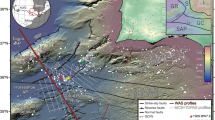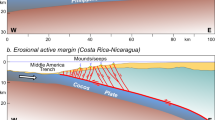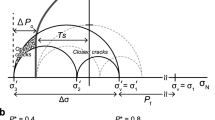Abstract
THE San Andreas fault near Parkfield, California has experienced moderate to large earthquakes about every 20 years since 1881, the most recent of which occurred in 19661–3. Statistical recurrence and precursory quiescence models1,4,5 led to a prediction of the next event for 1992 or before, but this event has not yet occurred. Here I present a model6 that attributes the 'non-occurrence' of the expected earthquake to the influence of adjacent thrusting on the rate of fault weakening from increasing pore pressures within the fault zone. Reductions in fault-normal strain rates7–9, and the onset of seismic quiescence along the San Andreas fault, both coincide with adjacent blind thrust faulting in the 1982–85 earthquake sequence of New Idria, Coalinga and Kettleman Hills. These events 'turned off' a compaction-induced weakening mechanism and extended the (proposed) seismic cycle at Parkfield. A model simulation of this effect shows a strong correlation in space and time of calculated and observed earthquake hypocentres, and shows that observed seismicity patterns from 1969–95 can be explained by reduced compaction rates brought on by adjacent thrusting. The model may have applications to other linked thrust/strike-slip fault systems, such as are found in southern California and other transpressional regions.
This is a preview of subscription content, access via your institution
Access options
Subscribe to this journal
Receive 51 print issues and online access
$199.00 per year
only $3.90 per issue
Buy this article
- Purchase on Springer Link
- Instant access to full article PDF
Prices may be subject to local taxes which are calculated during checkout
Similar content being viewed by others
References
Bakun, W. H. & Lindh, A. G. Science 229, 619–624 (1985).
Bakun, W. H. & McEvilly, T. V. J. Geophys. Res. 89, 3051–5058 (1984).
Roeloffs, E. & Langbein, J. Rev. Geophys. 32, 315–336 (1994).
Wyss, M., Bodin, P. & Habermann, R. E. Nature 345, 428–431 (1990).
Savage, J. C. Bull. Seismol. Soc. Am. 83, 1–6 (1993).
Miller, S. A., Nur, A. & Olgaard, D. L. Geophys. Res. Lett. 23, 197–200 (1996).
Harris, R. A. & Segall, P. J. Geophys. Res. 92, 7945–7962 (1987).
Dong, D. thesis, Massachusetts Inst. Technol. (1993).
Langbein, J. O., Burford, R. O. & Slater, L. E. J. Geophys. Res. 95, 2533–2552 (1990).
Stein, R. S. & Ekström, G. J. Geophys. Res. 97, 4865–4883 (1992).
Habermann, R. E. Bull. Seismol. Soc. Am. 77, 141–159 (1987).
Poley, C. M., Lindh, A. G., Bakun, W. H. & Schulz, S. S. Nature 327, 134–137 (1987).
Mavko, G. M., Schulz, S. & Brown, B. D. Bull. Seismol. Soc. Am. 75, 475–489 (1985).
Simpson, R. W., Schulz, S. S., Dietz, L. D. & Burford, R. O. Pure Appl. Geophys. 126, 665–685 (1988).
Wyss, M., Westerhaus, M., Berckhemer, H. & Ates, R. Geophys. J. Int. 123, 117–124 (1995).
King, N. E., Segall, P. & Prescott, W. J. Geophys. Res. 92, 2747–2766 (1987).
Johnson, P. A. & McEvilly, T. V. J. Geophys. Res. 100, 12937–12950 (1995).
Nadeau, R. M., Foxall, W. & McEvilly, T. V. Science 267, 503–507 (1995).
Rice, J. R. in Fault Mechanics and Transport Properties of Rocks (eds Evans, B. & Wong, T.-f.) 476–503 (Academic, San Diego, 1992).
Lockner, D. A. & Byerlee, J. D. Pure appl. Geophys. 145, 717–745 (1995).
Sleep, N. H. & Blanpied, M. L. Nature 359, 687–692 (1992).
Segall, P. & Rice, J. R. J. Geophys. Res. 100, 22155–22171 (1995).
Byerlee, J. D. Geophys. Res. Lett. 17, 2109–2112 (1990).
Ben-Zion, Y. & Rice, J. R. J. Geophys. Res. 98, 14109–14131 (1993).
Stuart, W. D., Archuleta, R. J. & Lindh, A. G. J. Geophys. Res. 90, 592–604 (1985).
Chinnery, M. A. Bull Seismol. Soc. Am. 53, 921–932 (1963).
Bak, P. & Tang, C. J. Geophys. Res. 94, 15635–15637 (1989).
Scholz, C. H. The Mechanics of Earthquakes and Faulting (Cambridge Univ. Press, 1990).
Sibson, R. H. Earth Sci. Rev. 32, 141–144 (1992).
Wyss, M. Geophys. Res. Lett. 18, 617–621 (1991).
Ben-Zion, Y., Rice, J. R. & Dmowska, R. J. Geophys. Res. 98, 2135–2144 (1993).
Author information
Authors and Affiliations
Rights and permissions
About this article
Cite this article
Miller, S. Fluid-mediated influence of adjacent thrusting on the seismic cycle at Parkfield. Nature 382, 799–802 (1996). https://doi.org/10.1038/382799a0
Received:
Accepted:
Issue Date:
DOI: https://doi.org/10.1038/382799a0
This article is cited by
-
Depth dependent stress revealed by aftershocks
Nature Communications (2017)
-
Nonlinear dynamics, granular media and dynamic earthquake triggering
Nature (2005)
Comments
By submitting a comment you agree to abide by our Terms and Community Guidelines. If you find something abusive or that does not comply with our terms or guidelines please flag it as inappropriate.



